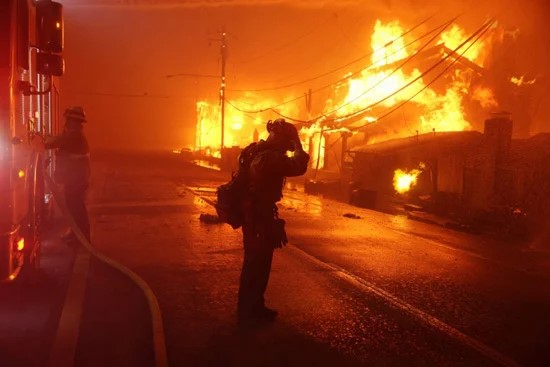Amid the devastating wildfires raging across Southern California, over 900 incarcerated individuals are among the more than 7,500 personnel working tirelessly to combat the flames. These five major wildfires have wreaked havoc, destroying homes, businesses, and significant landmarks throughout Los Angeles.
As of Friday, firefighters began to make headway against two of the largest wildfires on both the eastern and western sides of the city, aided by a welcome reduction in the fierce winds that had fueled the fires for days. Since Tuesday, six simultaneous wildfires have ravaged neighborhoods in Los Angeles County, resulting in at least 11 fatalities and damaging or completely destroying around 10,000 structures. These figures are expected to rise as firefighters continue their house-to-house searches when conditions allow.
According to a statement from California's Department of Corrections and Rehabilitation, “As of today, 939 Fire Camp firefighters have been working around the clock, creating fire lines and clearing vegetation behind structures to slow the spread of the flames, including 110 support staff.” This approach of utilizing incarcerated individuals for firefighting is not new; California has employed this practice since 1915, and it has been a part of emergency response efforts across the nation for centuries, as highlighted by Bianca Tylek, executive director of the criminal justice advocacy organization Worth Rises.
The easing of winds allowed firefighters to gain some control over the most significant blazes in the Los Angeles metropolitan area on Friday. However, meteorologists warned that gusty conditions would return over the weekend, complicating efforts in an area that has not seen rainfall in over eight months.
Bridget Berg, who witnessed her home in Altadena ignite while at work, returned with her family two days later to confront the reality of their loss. "We came back just to make it real," she said, as they walked on the remnants of what had been their home for the past 16 years.
Part of the ongoing investigation into the fires will likely focus on a crucial element in firefighting: water supply. On Wednesday morning, as the flames surged due to high winds, firefighters reported a concerning development over radio communications. One firefighter alerted dispatch, "We’ve lost most of the hydrant pressure," while another noted, "Got dry hydrants."
The wildfires have incinerated over 12,000 homes and other structures since they began erupting in the densely populated area just north of downtown Los Angeles. The cause of the largest blazes remains undetermined. Critics, including Tylek, view the use of incarcerated firefighters as exploitative.
Compounding the firefighting challenges, a nearby reservoir was reported to be undergoing repairs and was empty during the crisis, further diminishing water resources. In response to these issues, California Governor Gavin Newsom called for an independent investigation into the water supply problems faced by firefighters battling the wildfires. In a letter, he expressed concern over the reports of lost water pressure in local hydrants and the unavailability of supplies from the Santa Ynez Reservoir, emphasizing the need for answers to prevent future occurrences.
In Altadena, where the Eaton Fire ignited on Tuesday evening, issues with dry hydrants were linked to power outages, according to Bob Gomperz, a board member of a local water supplier. The California Department of Corrections states that those participating in the firefighting program do so voluntarily and receive compensation ranging from $5.80 to $10.24 per day, with additional pay during emergencies.
This controversial practice provides essential personnel support, especially as California faces increasingly severe fire seasons exacerbated by climate change. On the first full day of the wildfires, fire crews in the Los Angeles area were engaged in combatting multiple large blazes simultaneously, stretching the county’s emergency response capabilities, as noted by LA County Fire Chief Anthony Marrone.
As of Friday, approximately 153,000 residents in Los Angeles County are under evacuation orders, many having fled their homes with only a handful of belongings. An additional 166,000 residents are under evacuation warnings, indicating they may need to leave soon. The fires have resulted in the destruction of over 10,000 buildings, marking the most catastrophic wildfires in Los Angeles history. An estimated 60,000 more structures are at risk, with insured losses projected to exceed $8 billion due to the high value of the affected properties.
On Thursday afternoon, a man was arrested after residents suspected he was attempting to start a new fire. Police reported that he was charged with a probation violation but lacked sufficient probable cause to pursue arson charges, and investigations are ongoing. The origins of the initial fires have yet to be determined.
In response to concerns about looting in evacuated neighborhoods, National Guard troops have been deployed in some areas, with plans for additional troops to follow. So far, police have made 20 arrests related to looting incidents.
Zainab Y.
Also on site :
- Final Palisades fire evacuation order lifted
- 'Unprecedented' number of US Air Force aerial refueling tankers heading toward Europe
- A hillside of white crosses fuels a misleading story about South Africa’s farm killings

